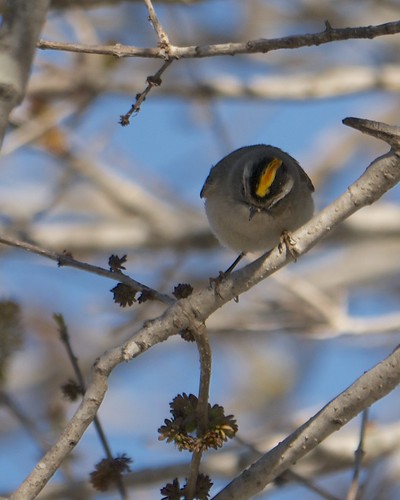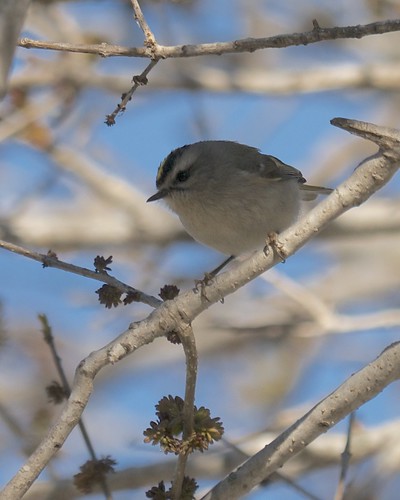I encountered this male Golden-crowned Kinglet this morning on Stillforest near where it meets Meadowheath. And I got the two best photos I've ever gotten of this species. This first photo shows where it gets its common name. Females have a yellow crest on top of their heads, and males have a yellow and orange crest.
These are tiny birds that are just here in the winter, and their presence in the winter in the Austin area is sporadic. Some years we see them and some years we don't. This year has been a good year to find Golden-crowned Kinglets in central Texas, as well as other sporadic winter birds like Red-breasted Nuthatches and Brown Creepers.
In spite of their bright crests, Golden-crowned Kinglets are rather inconspicuous.
They're mostly dull green and light grey, with dark stripes through the face, and light wing-bars accented with dark markings. Here's the other photo I got this morning, showing the striped face and just a little bit of the wing-bars.
Golden-crowned Kinglets are very similar to our much more common winter resident Ruby-crowned Kinglet, which has a big white eye-ring instead of stripes on its face. And only the male Ruby-crowned Kinglet has its namesake ruby crown, which it keeps hidden most of the time.
Seeing these little birds takes some work. They mostly eat insects and don't come to feeders, and they stay up in the tree canopy. They're usually found in mixed-species foraging flocks with Carolina Chickadees, Black-crested Titmice, Ruby-crowned Kinglets, Yellow-rumped Warblers, and a few other of our more common year-round or winter-resident songbirds. They have a very high-pitched call note which is usually repeated three times in a row. And they hardly ever hold still.
They breed mostly in the boreal conifer forests of Canada, but they've been gradually expanding their breeding range south. They occupy a variety habitats during the winter. I usually see them in pairs, and I wonder if breeding pairs stay together through the winter. Currently this is unknown.
Here are the other photos I took this morning. Here are the birds I saw between my house and Lake Creek Trail, and here are the birds I saw on Lake Creek Trail.



No comments:
Post a Comment